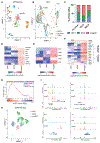A lactate-SREBP2 signaling axis drives tolerogenic dendritic cell maturation and promotes cancer progression
- PMID: 38728412
- PMCID: PMC11926670
- DOI: 10.1126/sciimmunol.adi4191
A lactate-SREBP2 signaling axis drives tolerogenic dendritic cell maturation and promotes cancer progression
Abstract
Conventional dendritic cells (DCs) are essential mediators of antitumor immunity. As a result, cancers have developed poorly understood mechanisms to render DCs dysfunctional within the tumor microenvironment (TME). After identification of CD63 as a specific surface marker, we demonstrate that mature regulatory DCs (mregDCs) migrate to tumor-draining lymph node tissues and suppress DC antigen cross-presentation in trans while promoting T helper 2 and regulatory T cell differentiation. Transcriptional and metabolic studies showed that mregDC functionality is dependent on the mevalonate biosynthetic pathway and its master transcription factor, SREBP2. We found that melanoma-derived lactate activates SREBP2 in tumor DCs and drives conventional DC transformation into mregDCs via homeostatic or tolerogenic maturation. DC-specific genetic silencing and pharmacologic inhibition of SREBP2 promoted antitumor CD8+ T cell activation and suppressed melanoma progression. CD63+ mregDCs were found to reside within the lymph nodes of several preclinical tumor models and in the sentinel lymph nodes of patients with melanoma. Collectively, this work suggests that a tumor lactate-stimulated SREBP2-dependent program promotes CD63+ mregDC development and function while serving as a promising therapeutic target for overcoming immune tolerance in the TME.
Conflict of interest statement
B.A.H. receives research funding from Merck & Co., Tempest Therapeutics, Lyell Therapeutics, and Iovance Therapeutics; is a consultant for Compugen and Amgen; and receives honoraria from HMP Education. G.M.B. receives research funding from Istari Oncology, Delcath, Oncosec Medical, Replimmune, and Checkmate Pharmaceuticals. The other authors declare that they have no competing interests.
Figures








References
-
- Wculek SK, Cueto FJ, Mujal AM, Melero I, Krummel MF, Sancho D, Dendritic cells in cancer immunology and immunotherapy. Nat. Rev. Immunol 20, 7–24 (2020). - PubMed
-
- Salmon H, Idoyaga J, Rahman A, Leboeuf M, Remark R, Jordan S, Casanova-Acebes M, Khudoynazarova M, Agudo J, Tung N, Chakarov S, Rivera C, Hogstad B, Bosenberg M, Hashimoto D, Gnjatic S, Bhardwaj N, Palucka AK, Brown BD, Brody J, Ginhoux F, Merad M, Expansion and activation of CD103+ dendritic cell progenitors at the tumor site enhances tumor responses to therapeutic PD-L1 and BRAF inhibition. Immunity 44, 924–938 (2016). - PMC - PubMed
-
- Broz ML, Binnewies M, Boldajipour B, Nelson AE, Pollack JL, Erle DJ, Barczak A, Rosenblum MD, Daud A, Barber DL, Amigorena S, Van’t Veer LJ, Sperling AI, Wolf DM, Krummel MF, Dissecting the tumor myeloid compartment reveals rare activating antigen-presenting cells critical for T cell immunity. Cancer Cell 26, 938 (2014). - PubMed
-
- Garris CS, Arlauckas SP, Kohler RH, Trefny MP, Garren S, Piot C, Engblom C, Pfirschke C, Siwicki M, Gungabeesoon J, Freeman GJ, Warren SE, Ong S, Browning E, Twitty CG, Pierce RH, Le MH, Algazi AP, Daud AI, Pai SI, Zippelius A, Weissleder R, Pittet MJ, Successful anti-PD-1 cancer immunotherapy requires T cell-dendritic cell crosstalk involving the cytokines IFN-γ and IL-12. Immunity 49, 1148–1161.e7 (2018). - PMC - PubMed
Publication types
MeSH terms
Substances
Grants and funding
LinkOut - more resources
Full Text Sources
Medical
Molecular Biology Databases
Research Materials
Miscellaneous

